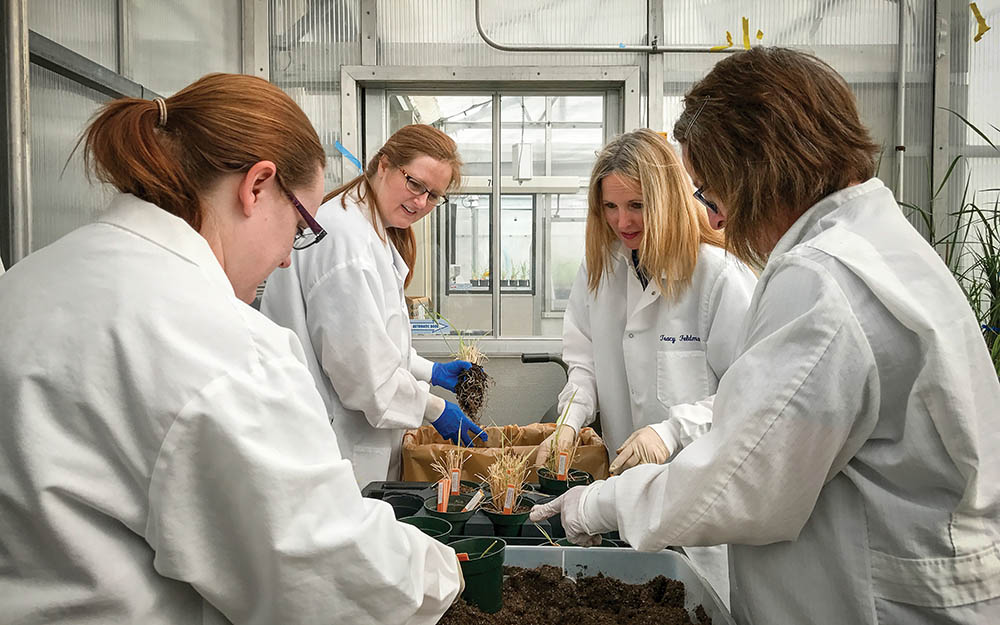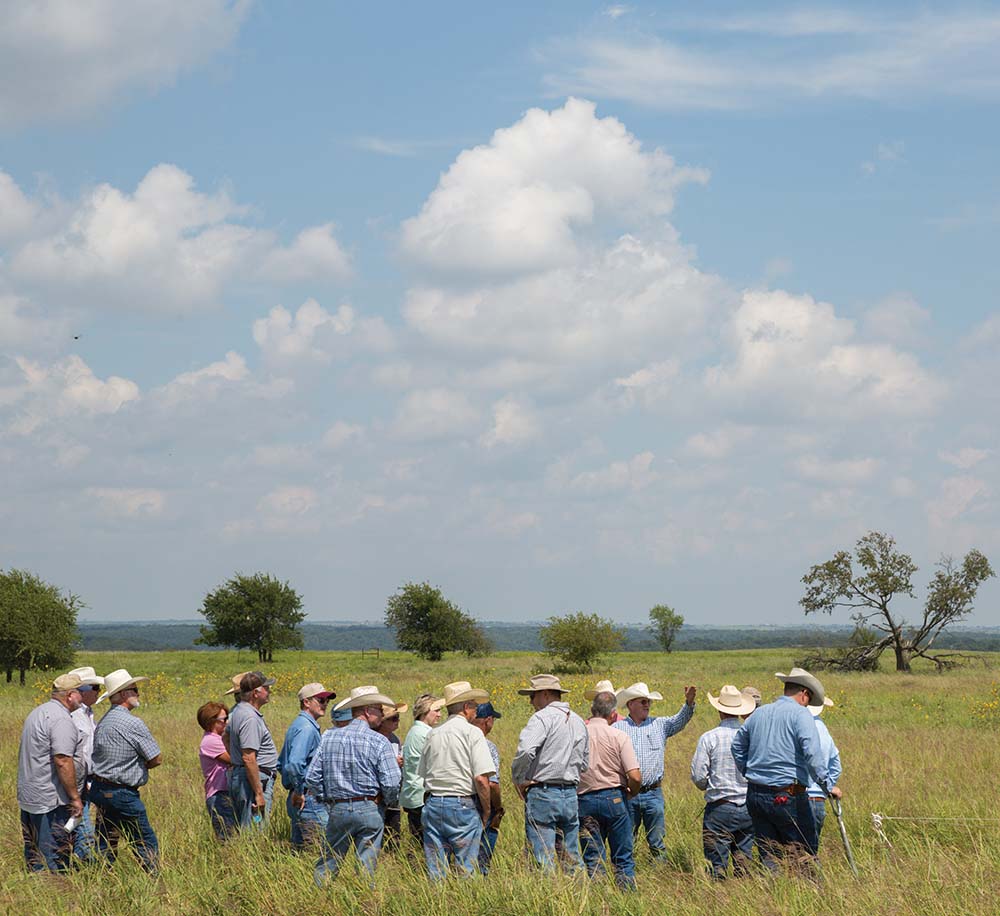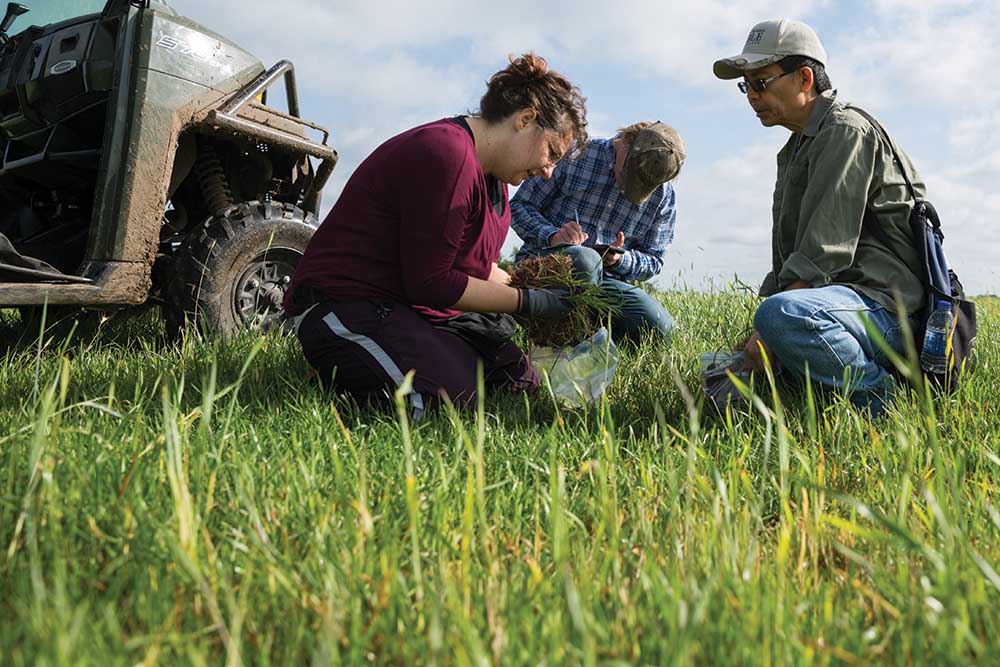Funding the Answers to Farmers’ Questions
U.S. farmers produce the world’s most abundant food supply, thanks, in part, to technological advancements. But with shrinking public funds available for agricultural research, new solutions are needed for funding continued innovation. Society depends on it.
Most Americans have never heard of Norman Borlaug, which is surprising given that he is credited with saving the lives of about 1 billion people.
As a plant scientist during the mid-20th century, the one-time Iowa farm boy was instrumental in developing a high-yield, short-stalk wheat that could be grown in various environments around the world.
Upon his death in 2009 at the age of 95, The New York Times said the crop varieties he produced “helped to avert mass famines that were widely predicted in the 1960s, altering the course of history.” His work earned him a Nobel Peace Prize and a Presidential Medal of Freedom.
And yet, Norman Borlaug’s name is rarely mentioned in history classes, if it is at all. Outside the world of agriculture, he’s pretty much unknown. One magazine called him “The Forgotten Benefactor of Humanity.” Another rated him #1 on a list called “6 People You’ve Never Heard of Who Probably Saved Your Life.”
Had he given humanity a new drug or vaccine, he would probably be remembered with great renown. But while society intuitively knows the benefits of medical research, the general public is largely detached from the faceless discoveries that preserve soil or cure diseases that threaten our food. And this lack of drama and visibility affects not only public interest but funding.
The past two decades have seen an erosion in public investment for agricultural research, causing many to worry that future farmers and ranchers may struggle to keep pace in a world that must support more people on less land.
“Outside of agriculture, not many people recognize the need for agricultural research. It’s not the kind of thing that evokes an emotional response in most givers,” says Steve Rhines, vice president and general counsel for the Noble Research Institute. “Agriculture has struggled with how to convey the ‘research is important and necessary’ story. Without an accessible story, we are challenged when seeking support from those outside of agriculture, including policymakers and consumers.”

The United States was once the top contributor of public funds for national research into food and agriculture. (“Public funds” take the form of government grants, allocations or direct appropriations.) But since 2009, the top spot has gone to China. U.S. contributions are also lower than the total for the developed nations of Western Europe and the Asia Pacific region.
In total, federal and state agencies spent about $3.8 billion on agricultural research and development in 2013 – a number that has been dropping since the beginning of the 2000s. And while almost $4 billion sounds like a lot, consider that the Department of Defense was allocated $71 billion in research in 2016. Federal spending on medical research topped $31 billion.
At the same time federal funds have contracted, so has public support of colleges and universities among state legislatures, says Paul Heisey, Ph.D., an agricultural economist at the U.S. Department of Agriculture. Public universities in the heartland – many of which are traditional power-houses for ag research – have been hit especially hard. Without large endowments to buffer their bottom lines, many land-grant universities have closed positions, reduced (or eliminated) departments and slashed their own research budgets.
What has declining public funds meant for science? As agricultural research spending has fallen, so has the proportion of research publications by American scientists in scientific journals, according to an analysis from the Economic Research Service conducted for the Organization for Economic Cooperation and Development. In 1996, more than one-third of all scientific citations for agricultural research were credited to U.S. scientists. By 2012, that number had fallen to 18 percent, as scientific output from the rest of the world rose.
Meanwhile, private industry is spending more than ever on agricultural research, at just more than $12 billion in 2013, the latest year with complete figures available. But private spending doesn’t necessarily offset a lack of government support.

While important discoveries come from commercial sources, “industry has different priorities,” Heisey says. For example, roughly half of private funds are spent looking for improvements in the manufacturing of food and feed. The two biggest categories for public sector funding fall under the heading of plant systems/crop protection and environment/natural resources, the latter of which has little to no industry investment at all. Industry research in crop science is tightly focused, Rhines says, concentrating mostly on just five row crops, including corn and soybeans.
Industry’s involvement in the research field also stands to further exacerbate the public disconnect for the need for publicly funded agricultural research, says Kent Schescke, executive vice president of the nonprofit Council for Agricultural Science and Technology. “It creates this perception that agriculture is run by big companies when in reality it is still very much a farmer-owned industry,” he says. As of the 2012 Census of Agriculture, which offers the most recent data, 97 percent of the 2.1 million farms in the U.S. are family-owned. The 3 percent that are nonfamily farms include those like the research and demonstration operations of the Noble Research Institute, a nonprofit research institution.
Since U.S. food is not in short supply, some scientific advancements even suffer backlash as they are seen as solely benefiting producers or the corporations that supply inputs. “People take it for granted that food is going to be there, and many consumers do not view innovation and technology as a good thing when it comes to their food,” said Schescke.
To help lawmakers better connect with agricultural science, the National Coalition for Food and Agriculture Research formed more than two decades ago. The group hosts luncheons that try to connect congressional staff members with what happens in research laboratories across the country and how research benefits consumers in easily recognizable ways. While the group has made some progress, ‘There are very real challenges,” says executive director Tom Van Arsdall. “It’s important, but how do you make funding for ag research and education competitive with other interests? I wish we had the answer.”

One hope is that newly established agricultural research organizations, or AROs, may help make up for support that has been lost elsewhere, Rhines said. Medical research organizations, typically established with private philanthropic funds, have existed for decades to help subsidize nonprofit health research using private wealth. One of them, the Howard Hughes Medical Institute, was founded in the 1950s and carries an endowment of $18 billion. Some are newer, such as the Stowers Institute for Medical Research in Kansas City, which opened in 2000. Those and others started because their founders had a passion for research.
With the creation of agricultural research organizations, a new type of 501(c)(3), Rhines hopes philanthropists will see the same need to support agricultural research as they do for medical causes.
For example: Shoppers go home from the grocery store every day with orange juice, unaware that citrus greening is consuming groves in Florida. The bacterial infection, spread by insects, has cost growers almost $5 billion over the past decade. University researchers are working to try to stop it.
“This is a disease that has a significant impact on a very strong industry in this country,” Rhines said. “Envision the establishment of a nonprofit research entity – an agricultural research organization – dedicated to the eradication of citrus greening. AROs represent a new opportunity for focus and dedication of resources for a specific outcome. These kinds of agricultural challenges exist everywhere. There is not a shortage of need.”



Comment